How-do-you-get-to-school公开课说课稿
- 格式:docx
- 大小:24.24 KB
- 文档页数:7
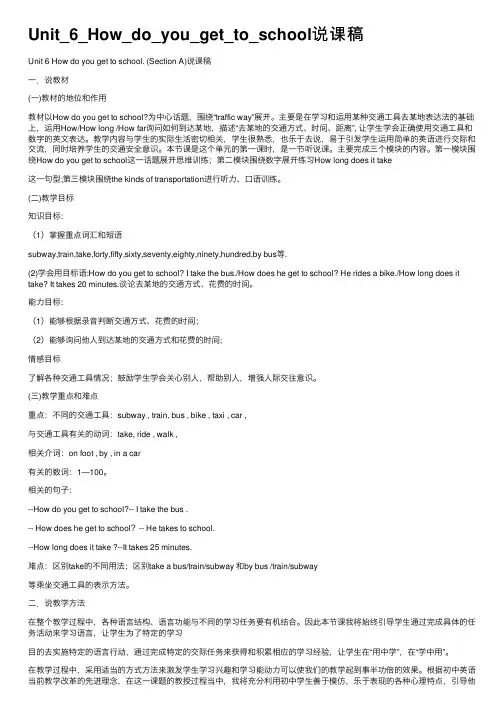
Unit_6_How_do_you_get_to_school说课稿Unit 6 How do you get to school. (Section A)说课稿⼀.说教材(⼀)教材的地位和作⽤教材以How do you get to school?为中⼼话题,围绕“traffic way”展开。
主要是在学习和运⽤某种交通⼯具去某地表达法的基础上,运⽤How/How long /How far询问如何到达某地,描述“去某地的交通⽅式、时间、距离”, 让学⽣学会正确使⽤交通⼯具和数字的英⽂表达。
教学内容与学⽣的实际⽣活密切相关,学⽣很熟悉,也乐于去说,易于引发学⽣运⽤简单的英语进⾏交际和交流,同时培养学⽣的交通安全意识。
本节课是这个单元的第⼀课时,是⼀节听说课。
主要完成三个模块的内容。
第⼀模块围绕How do you get to school这⼀话题展开思维训练;第⼆模块围绕数字展开练习How long does it take这⼀句型;第三模块围绕the kinds of transportation进⾏听⼒、⼝语训练。
(⼆)教学⽬标知识⽬标:(1)掌握重点词汇和短语subway,train,take,forty,fifty,sixty,seventy,eighty,ninety,hundred,by bus等.(2)学会⽤⽬标语:How do you get to school? I take the bus./How does he get to school? He rides a bike./How long does it take? It takes 20 minutes.谈论去某地的交通⽅式、花费的时间。
能⼒⽬标:(1)能够根据录⾳判断交通⽅式、花费的时间;(2)能够询问他⼈到达某地的交通⽅式和花费的时间;情感⽬标了解各种交通⼯具情况;⿎励学⽣学会关⼼别⼈,帮助别⼈,增强⼈际交往意识。
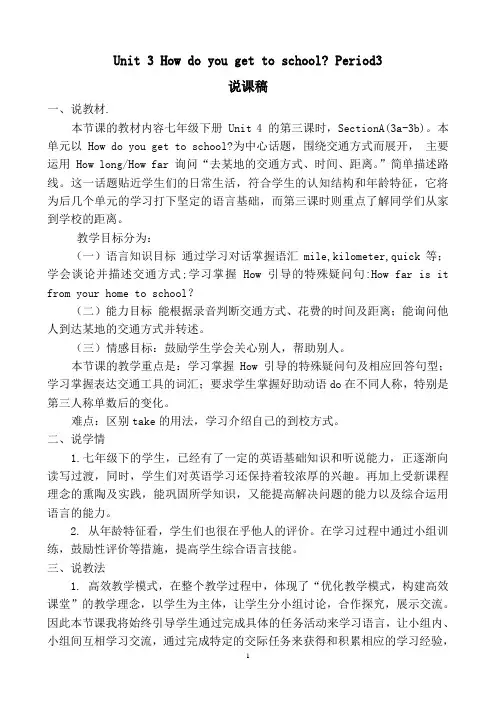
Unit 3 How do you get to school? Period3说课稿一、说教材.本节课的教材内容七年级下册 Unit 4 的第三课时,SectionA(3a-3b)。
本单元以 How do you get to school?为中心话题,围绕交通方式而展开,主要运用 How long/How far 询问“去某地的交通方式、时间、距离。
”简单描述路线。
这一话题贴近学生们的日常生活,符合学生的认知结构和年龄特征,它将为后几个单元的学习打下坚定的语言基础,而第三课时则重点了解同学们从家到学校的距离。
教学目标分为:(一)语言知识目标通过学习对话掌握语汇mile,kilometer,quick等;学会谈论并描述交通方式;学习掌握 How 引导的特殊疑问句:How far is it from your home to school?(二)能力目标能根据录音判断交通方式、花费的时间及距离;能询问他人到达某地的交通方式并转述。
(三)情感目标:鼓励学生学会关心别人,帮助别人。
本节课的教学重点是:学习掌握 How 引导的特殊疑问句及相应回答句型;学习掌握表达交通工具的词汇;要求学生掌握好助动语do在不同人称,特别是第三人称单数后的变化。
难点:区别take的用法,学习介绍自己的到校方式。
二、说学情1.七年级下的学生,已经有了一定的英语基础知识和听说能力,正逐渐向读写过渡,同时,学生们对英语学习还保持着较浓厚的兴趣。
再加上受新课程理念的熏陶及实践,能巩固所学知识,又能提高解决问题的能力以及综合运用语言的能力。
2. 从年龄特征看,学生们也很在乎他人的评价。
在学习过程中通过小组训练,鼓励性评价等措施,提高学生综合语言技能。
三、说教法1. 高效教学模式,在整个教学过程中,体现了“优化教学模式,构建高效课堂”的教学理念,以学生为主体,让学生分小组讨论,合作探究,展示交流。
因此本节课我将始终引导学生通过完成具体的任务活动来学习语言,让小组内、小组间互相学习交流,通过完成特定的交际任务来获得和积累相应的学习经验,让学生在用中学,在学中用。
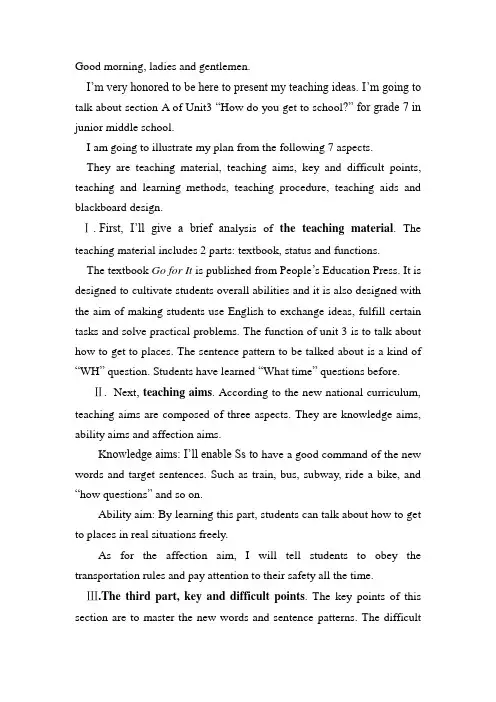
Good morning, ladies and gentlemen.I’m very honored to be here to present my teaching ideas. I’m going to talk about section A of Unit3 “How do you get to school?” for grade 7 in junior middle school.I am going to illustrate my plan from the following 7 aspects.They are teaching material, teaching aims, key and difficult points, teaching and learning methods, teaching procedure, teaching aids and blackboard design.Ⅰ.First, I’ll give a brief an alysis of the teaching material. The teaching material includes 2 parts: textbook, status and functions.The textbook Go for It is published from People’s Education Press. It is designed to cultivate students overall abilities and it is also designed with the aim of making students use English to exchange ideas, fulfill certain tasks and solve practical problems. The function of unit 3 is to talk about how to get to places. The sentence pattern to be talked about is a kind of “WH” question. Students have learned “What time” questions before.Ⅱ. Next, teaching aims. According to the new national curriculum, teaching aims are composed of three aspects. They are knowledge aims, ability aims and affection aims.K nowledge aims: I’ll enable Ss to have a good command of the new words and target sentences. Such as train, bus, subway, ride a bike, and “how questions” and so on.Ability aim: By learning this part, students can talk about how to get to places in real situations freely.As for the affection aim, I will tell students to obey the transportation rules and pay attention to their safety all the time.Ⅲ.The third part, key and difficult points. The key points of this section are to master the new words and sentence patterns. The difficultpoint is to talk about how to get to places in real situations freely.Ⅳ.Let’s come to the forth part, teaching and learning methods. The new national curriculum advocates that language is for communication. F or this purpose, I’ll mainly adopt 2 teaching methods. They are task-based language teaching and communicative language teaching. Here I’ll mainly talk about Task-based language teaching, that is to say, in my class I’ll design different activities and get students to fulfill the tasks. In that way, students will learn to experience and explore to improve their overall abilities. As for learning methods, I think students should learn how to cooperate with others, of course, they should also know how to learn by themselves, and so I will use cooperative learning method and autonomous learning method.Ⅴ.OK, let’s turn to the most important part, teaching procedure. I’ll arrange 6 steps in this part: lead in, pre-task, task-cycle, post-task, conclusion and homework. First, lead in. I will chat with students by comparing the vehicles in the ancient time and the present time. I will design such a situation: There are two people, and one is from the ancient time, while the other is from the present time. Both of them want to go to a place which is far from them. How do they get there? Apparently, the ancient boy will walk, and walk tiredly to get there. Now, I will ask students how about the present boy. Students will answer my question with several transportation means. At this time, I will show students cards and tell them the related English words. After that, students get familiar with the new words, and then I will move to the 2nd step, pre-task. I will use autonomous learning method and let students remember the new words by themselves within several minutes, and after that, I will check the words by showing the cards. Let’s come to the 3rd step, Task-cycle. In order to make students understand “How questions”clearly. I willbuild the relationship with the last lesson. Students have learned “What time do you go to school” in the last lesson. I will replace “what time”with “how”, and ask students the sentence meaning, and then I will ask a student to answer this question. After this leading, I will make students master the dialogue through pair work. Since students have learned “how”question, “how far”question and “how long”question will be easy for students to learn. Here, I think the conversation in 2e is a good material to learn the sentence patterns, so I will let students make a role-play of the conversation in 2e. At the moment, students have learned all the language points. It’s time to consolidate them. I will move to the 4th part, post-task. Students make up a dialogue with their partners according to a map which signs the length between the buildings. I will lead students to finish 2a, 3a, 3b in the textbook.Conclusion: With some practice above, the whole class will go into the conclusion time. Firstly, I’ll summarize the useful expressions. Secondly, I will tell students although kinds of vehicles can bring us convenience, it brings us dangers. We should obey the transportation rules and be careful of our safety all the time.The last step, homework. I’ll give students 2 homework. One is to write each new word for 5 times; the other is to recite the conversation in 2e.Ⅵ.After illustrating the procedure, let’s come to the sixth part, teaching aids. I will use cards to help students learn the new words.Ⅶ.The last part, blackboard design. I design the blackboard in this way. I’ll write some ke y words and phrases on the left, and target sentences on the right.That’s all for my teaching plan. Thanks for your attention!。
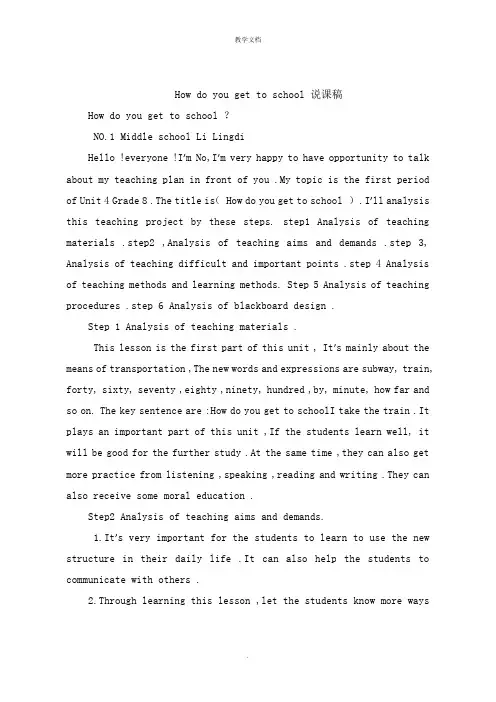
How do you get to school 说课稿How do you get to school ?NO.1 Middle school Li LingdiHello !everyone !I’m No,I’m very happy to have opportunity to talk about my teaching plan in front of you .My topic is the first period of Unit 4 Grade 8 .The title is( How do you get to school ) .I’ll analysis this teaching project by these steps. step1 Analysis of teaching materials .step2 ,Analysis of teaching aims and demands .step 3, Analysis of teaching difficult and important points .step 4 Analysis of teaching methods and learning methods. Step 5 Analysis of teaching procedures .step 6 Analysis of blackboard design .Step 1 Analysis of teaching materials .This lesson is the first part of this unit , It’s mainly about the means of transportation ,The new words and expressions are subway, train, forty, sixty, seventy ,eighty ,ninety, hundred ,by, minute, how far and so on. The key sentence are :How do you get to schoolI take the train .It plays an important part of this unit ,If the students learn well, it will be good for the further study .At the same time ,they can also get more practice from listening ,speaking ,reading and writing .They can also receive some moral education .Step2 Analysis of teaching aims and demands.1.It’s very important for the students to learn to use the new structure in their daily life .It can also help the students to communicate with others .2.Through learning this lesson ,let the students know more waysabout traffic.Step 3Analysis of teaching difficult and important points1. Train the students to use the structure: How do you get to schoolI take the train .2. Train the students to use some other ways to describe.3.Train the students to understand the target language in spoken conversations with others.Step 4 Analysis of teaching methods and learning methods.According to the facts of the students and materials, I’ll use the following methods : listening and making conversations in pairs ,Think of examples from the students’ real life : Role playing Step5 Analysis of teaching procedures.I think this is the most important part of these steps. First in order to let the students become more interested in English. I’ll show some pictures to the students, discuss them with the students together by asking some questions about new lesson. At the same time ,write the new words and structures on the blackboard. Let the students repeat till they understand and learn to use them. Next listen to recording, first finish 1b and repeat 2a. Before listening to 2c, explain the meanings of all the sentences and pictures. Then play the recording for the first time. The students only listen, play it for the second time, check the right pictures and then share the answers. If the students make some mistakes correct them,there’re three parts of listening in 1b. 2a and 2c.During the listening they’ll find something new. For the students.I think they should try to guess the meanings of the new parts. For theteacher. I think I should provide enough help for my students and help them to understand the new parts. After learning these four parts. I’ll add 1c to 2d.Let the students practice in pairs by using the target language. At last. I’ll guide my students to revise the grammar focus. Ask them to pay attention to the new structure. After that I’ll give them five minutes to go over the key points. Then let them do some exercises to reflect the result of this lesson. The homework is to make up some new sentences. I do this to improve their ability of writing.Step 6.Analysis of blackboard design .I only write down the target language on the Bb. There are only four sentences. It looks clean and makes the students think it’s easy to learn.I want to make it inductive,instructive and artistic. This is my teaching plan. That’ s all thank you for listening !。
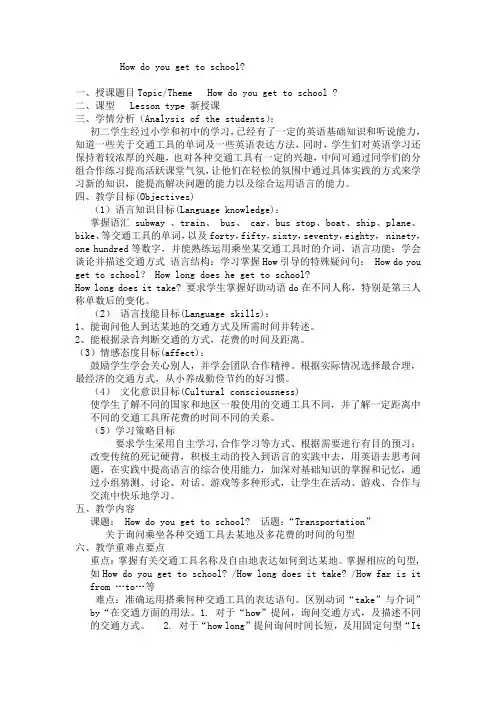
How do you get to school?一、授课题目Topic/Theme How do you get to school ?二、课型 Lesson type 新授课三、学情分析(Analysis of the students):初二学生经过小学和初中的学习,已经有了一定的英语基础知识和听说能力,知道一些关于交通工具的单词及一些英语表达方法,同时,学生们对英语学习还保持着较浓厚的兴趣,也对各种交通工具有一定的兴趣,中间可通过同学们的分组合作练习提高活跃课堂气氛,让他们在轻松的氛围中通过具体实践的方式来学习新的知识,能提高解决问题的能力以及综合运用语言的能力。
四、教学目标(Objectives)(1)语言知识目标(Language knowledge):掌握语汇subway 、train、 bus、 car、bus stop、boat、ship、plane、bike、等交通工具的单词,以及forty,fifty,sixty,seventy,eighty, ninety,one hundred等数字,并能熟练运用乘坐某交通工具时的介词,语言功能:学会谈论并描述交通方式语言结构:学习掌握How引导的特殊疑问句: How do you get to school? How long does he get to school?How long does it take? 要求学生掌握好助动语do在不同人称,特别是第三人称单数后的变化。
(2)语言技能目标(Language skills):1、能询问他人到达某地的交通方式及所需时间并转述。
2、能根据录音判断交通的方式,花费的时间及距离。
(3)情感态度目标(affect):鼓励学生学会关心别人,并学会团队合作精神。
根据实际情况选择最合理,最经济的交通方式,从小养成勤俭节约的好习惯。
(4)文化意识目标(Cultural consciousness)使学生了解不同的国家和地区一般使用的交通工具不同,并了解一定距离中不同的交通工具所花费的时间不同的关系。

Unit3 How do you get to school?建平镇中学董莲凤各位领导,各位老师:大家好!我说课的内容是人教版《go for it 》七年级下册第三单元How do you get to school?的第一课时,即SectionA的1a-1c部分。
下面我从以下7方面来说一下我对这一课的认识及我的教学实施过程。
一、教材分析1、教材的地位及作用本单元的话题涉及学生上学的交通方式,与上一单元关于上学时间的话题紧密相连。
SectionA 部分展现了学生以不同的交通方式上学的场景,自然而然地将学生带入到有关彼此上学方式、出行花费的时间以及家与学校的之间的距离等问题的讨论中。
本单元的第一课时则是通过1a,1b 和1c三个主要内容的学习,来引出本单元的语言和知识目标,学习了常见的交通方式的表达,并让学生初步感知和学习“How do you get to school?”“I walk.”"How does she get to school?She takes the subway. "这样的句型,为进一步深入学习由“How long…”和“How far…?”引导的句型作好铺垫。
二、学生情况分析:对于七年级的学生来说,他们在经过七年级上个学期的英语学习后,已具有了一定的英语基础知识,同时也具备一些运用语言知识的能力。
在这样的基础上,学生对于讨论跟他们生活息息相关的内容,会很容易产生兴趣。
三、教学目标的制定根据课程标准的要求,教材的地位及作用和学生的实际情况我确立如下三方面的教学目标:即知识目标、能力目标和情感目标。
1. 知识目标:1)通过本节课的学习,使学生熟练掌握表示常见的交通工具的英文单词,如bus, train, bike, car. subway , 以及出行方式的英文表达法如:walk ,ride a bike, take the bus,drive a car , by bus ,on foot。
![Unit3_How_do_you_get_to_school第一课时说课稿[1]](https://uimg.taocdn.com/800a92137dd184254b35eefdc8d376eeaeaa176a.webp)
Unit3 How do you get to school?SectionB(2a-2c)(说课稿)一、说教学重点与难点:根据教学大纲的要求,及本课在教材中所处的地位和作用,确定本课的重难点为:1、教学重点:学会不同的交通工具(subway , train, bus , bike , taxi , car ,)与交通工具相关的动词(take, ride , walk),相关介词:(on foot , by , in a car )使用--How do you get to school?-- I take the bus .谈论相关话题。
2、教学难点:使用上面所学词汇和句子,使用不同人称围绕对话主题实行操练,并能熟练使用。
二、学情分析1、初中学生的抽象思维水平较低,形象思维水平强,但注意力容易分散。
本课采用多种形式展示,并配以丰富的色彩,从而增强学生的兴趣和注意力。
2、初中生的学习心理特点是:对英语普遍感兴趣,但有很大的不稳定性,好奇心强,求知欲旺盛,已不满足教师对课文的简单重复。
在本课教学过程中,注重启发引导,培养学生分析、概括水平的同时,更要注重教学方法的灵活性,通过任务型教学法,情景交际法,全身反应教学法等,激发学生学习的兴趣,让学生乐于接受,易于接受。
三、学法指导《英语课程标准》把"培养学生学习英语的兴趣,树立自信心,培养良好学习习惯和形成有效策略,发展自主学习和合作精神"放在了首位。
依据这个前提,我从以下几个方面对学生实行学法指导。
1、学习方法的指导:培养学生观察力,想象力,记忆力以及思维水平。
用生动的课件调动学生的感官实行听说读写的训练。
2、学习积极性的调动:我在教学过程中创造一种开放的,和谐的,积极互动的语言气氛,把课堂变成有声有色的舞台,让学生在乐中学。
3、学习水平的培养:通过连接的听说读写,游戏,竞赛等,培养学生的交际水平,发展他们的思维水平。
四:教学步骤Teaching aims:a.培养学生的阅读水平和写作水平。
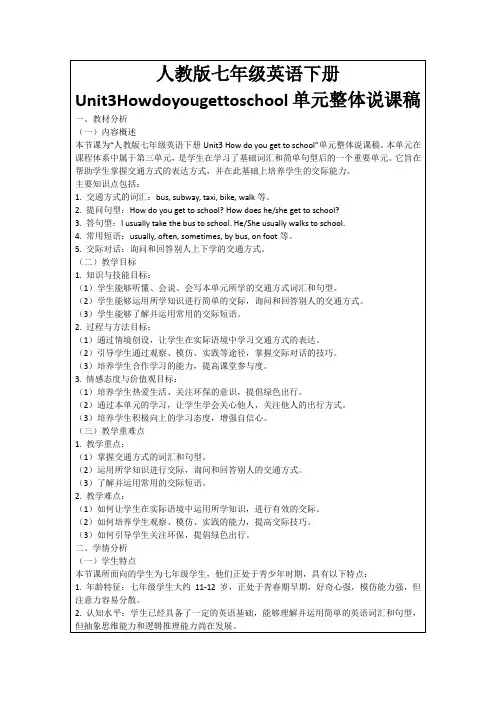
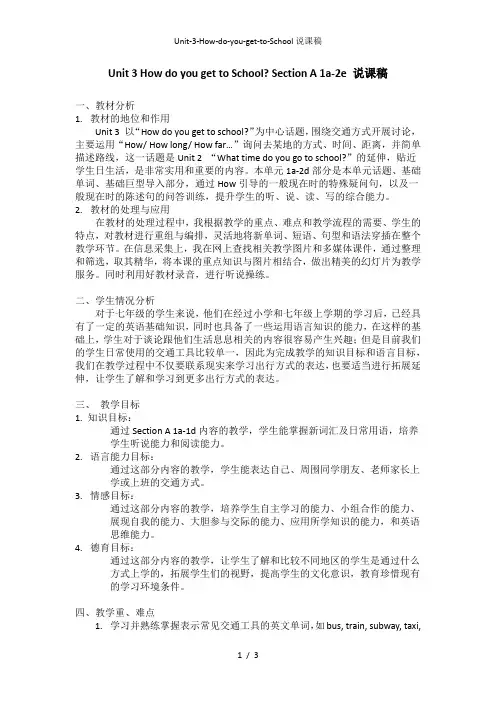
Unit 3 How do you get to School? Section A 1a-2e 说课稿一、教材分析1.教材的地位和作用Unit 3 以“How do you get to school?”为中心话题,围绕交通方式开展讨论,主要运用“How/ How long/ How far…”询问去某地的方式、时间、距离,并简单描述路线,这一话题是Unit 2 “What time do you go to school?”的延伸,贴近学生日生活,是非常实用和重要的内容。
本单元1a-2d部分是本单元话题、基础单词、基础巨型导入部分,通过How引导的一般现在时的特殊疑问句,以及一般现在时的陈述句的问答训练,提升学生的听、说、读、写的综合能力。
2.教材的处理与应用在教材的处理过程中,我根据教学的重点、难点和教学流程的需要、学生的特点,对教材进行重组与编排,灵活地将新单词、短语、句型和语法穿插在整个教学环节。
在信息采集上,我在网上查找相关教学图片和多媒体课件,通过整理和筛选,取其精华,将本课的重点知识与图片相结合,做出精美的幻灯片为教学服务。
同时利用好教材录音,进行听说操练。
二、学生情况分析对于七年级的学生来说,他们在经过小学和七年级上学期的学习后,已经具有了一定的英语基础知识,同时也具备了一些运用语言知识的能力,在这样的基础上,学生对于谈论跟他们生活息息相关的内容很容易产生兴趣;但是目前我们的学生日常使用的交通工具比较单一,因此为完成教学的知识目标和语言目标,我们在教学过程中不仅要联系现实来学习出行方式的表达,也要适当进行拓展延伸,让学生了解和学习到更多出行方式的表达。
三、教学目标1. 知识目标:通过Section A 1a-1d内容的教学,学生能掌握新词汇及日常用语,培养学生听说能力和阅读能力。
2.语言能力目标:通过这部分内容的教学,学生能表达自己、周围同学朋友、老师家长上学或上班的交通方式。
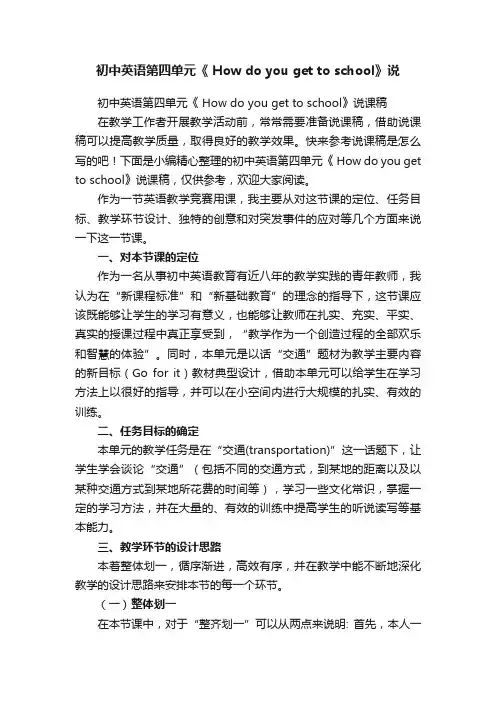
初中英语第四单元《 How do you get to school》说初中英语第四单元《 How do you get to school》说课稿在教学工作者开展教学活动前,常常需要准备说课稿,借助说课稿可以提高教学质量,取得良好的教学效果。
快来参考说课稿是怎么写的吧!下面是小编精心整理的初中英语第四单元《 How do you get to school》说课稿,仅供参考,欢迎大家阅读。
作为一节英语教学竞赛用课,我主要从对这节课的定位、任务目标、教学环节设计、独特的创意和对突发事件的应对等几个方面来说一下这一节课。
一、对本节课的定位作为一名从事初中英语教育有近八年的教学实践的青年教师,我认为在“新课程标准”和“新基础教育”的理念的指导下,这节课应该既能够让学生的学习有意义,也能够让教师在扎实、充实、平实、真实的授课过程中真正享受到,“教学作为一个创造过程的全部欢乐和智慧的体验”。
同时,本单元是以话“交通”题材为教学主要内容的新目标(Go for it)教材典型设计,借助本单元可以给学生在学习方法上以很好的指导,并可以在小空间内进行大规模的扎实、有效的训练。
二、任务目标的确定本单元的教学任务是在“交通(transportation)”这一话题下,让学生学会谈论“交通”(包括不同的交通方式,到某地的距离以及以某种交通方式到某地所花费的时间等),学习一些文化常识,掌握一定的学习方法,并在大量的、有效的训练中提高学生的听说读写等基本能力。
三、教学环节的设计思路本着整体划一,循序渐进,高效有序,并在教学中能不断地深化教学的设计思路来安排本节的每一个环节。
(一)整体划一在本节课中,对于“整齐划一”可以从两点来说明: 首先,本人一直认为作为语言教学,听说读写等能力的训练应该是一个整体,不可分割开来的,因此在教学设计中可以说一个话题,一个训练都蕴含着各种能力的培养;其次,在教学中每一节课都是独立的,但在我的教学设计中每一节课不仅可以独立,更重视它在单元教学整体中的地位与作用。
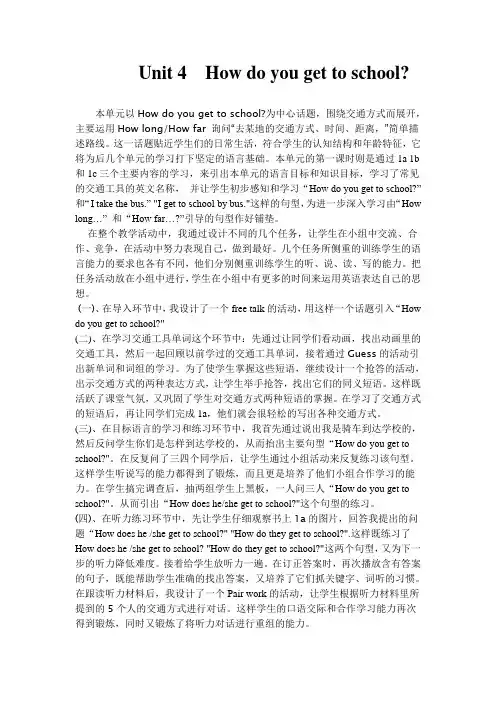
Unit 4 How do you get to school?本单元以How do you get to school?为中心话题,围绕交通方式而展开,主要运用How long/How far 询问“去某地的交通方式、时间、距离,”简单描述路线。
这一话题贴近学生们的日常生活,符合学生的认知结构和年龄特征,它将为后几个单元的学习打下坚定的语言基础。
本单元的第一课时则是通过1a 1b 和1c三个主要内容的学习,来引出本单元的语言目标和知识目标,学习了常见的交通工具的英文名称,并让学生初步感知和学习“How do you get to school?”和“I take the bus.” "I get to school by bus."这样的句型,为进一步深入学习由“How long…” 和“How far…?”引导的句型作好铺垫。
在整个教学活动中,我通过设计不同的几个任务,让学生在小组中交流、合作、竞争,在活动中努力表现自己,做到最好。
几个任务所侧重的训练学生的语言能力的要求也各有不同,他们分别侧重训练学生的听、说、读、写的能力。
把任务活动放在小组中进行,学生在小组中有更多的时间来运用英语表达自己的思想。
(一)、在导入环节中,我设计了一个free talk的活动,用这样一个话题引入“How do you get to school?"(二)、在学习交通工具单词这个环节中:先通过让同学们看动画,找出动画里的交通工具,然后一起回顾以前学过的交通工具单词,接着通过Guess的活动引出新单词和词组的学习。
为了使学生掌握这些短语,继续设计一个抢答的活动,出示交通方式的两种表达方式,让学生举手抢答,找出它们的同义短语。
这样既活跃了课堂气氛,又巩固了学生对交通方式两种短语的掌握。
在学习了交通方式的短语后,再让同学们完成1a,他们就会很轻松的写出各种交通方式。
(三)、在目标语言的学习和练习环节中,我首先通过说出我是骑车到达学校的,然后反问学生你们是怎样到达学校的,从而抬出主要句型“How do you get to school?"。
八年级(上)Unit 4 How do you get to school说课稿一、说教材(一)、教材的地位和作用本单元以how do you get to school?为中心话题,围绕交通方式而绽开,主要运用how long/how far 询问“去某地的交通方式、时间、距离。
”简洁描述路线。
这一话题贴近同学们的日常生活,它继第三单元谈论“假日方案”后支配这样一个话题,符合同学的认知结构和年龄特征,它将为后几个单元的学习打下坚决的语言基础。
而seetiona第一课时重点则采访同学们上学的交通方式,及花费的时间、距离等等。
(二)、教学目标(语言学问力量目标情感目标)语言学问:1、语言目标,把握语汇subway 、train、 bus、 car、bus stop等。
语言功能:学会谈论并描述交通方式语言结构:学习把握how引导的特别疑问句:how do you get to school? how long does he get to school?how long does it take?要求同学把握好助动语do在不同人称,特殊是第三人称单数后的变化。
2、语言技能1、能依据录音推断交通的方式,花费的时间及距离。
2、能询问他人到达某地的交通方式并转述。
力量目标:1、培育同学听、说、读、写的力量。
2、训练同学小组合作的力量。
3、让同学通过有用的目标语言学会与他人沟通的力量。
情感目标:鼓舞同学学会关怀别人,关心别人。
(三)、教学重点和难点重点:关心同学学会使用how do you get to school?i take the train to school.how does he get to school?he takes the bus to school.进行交际难点:区分take 的用法。
二、说教学方法(一)、学情分析1、初二同学经过学校和学校的学习,已经有了肯定的英语基础学问和听说力量,正渐渐向读写过渡,同时,同学们对英语学习还保持着较深厚的爱好。
Unit3 How do you get to school?SectionB 1a—1e 说课稿一、说教材1.教材分析本单元的话题是“谈论如何去某地”,它与我们日常生活密切联系,生活离不开“行”。
本单元就是描述人们日常出行的的主要方式,学习一般现在时。
其中,SectionB 的教学是在学习完SectionA 的基础上展开的,重视读、写,设置了运用所学语言去完成各项任务,使学生能够对已经学过的目标句型运用自如。
2.教学目标:⑴知识目标①学生能掌握stop,think of 等单词。
②复习巩固how long/far 引导的特殊疑问句用于询问乘交通工具从某地到另一地所耗费的时间及两地间的距离。
⑵能力目标熟练运用how引导的特殊疑问句来询问出行方式⑶情感目标让学生感受到他们学英语是为了在现实中进行交流,了解东西方国家出行方式的不同,以及不同的交通规则,教育学生注意交通安全,加深对交通知识的了解。
3.重难点分析重点:⑴掌握有关交通方式的词汇,如take the subway/train, ride a bike, by bus/boat, bus stop, train station以及其他词汇⑵学会运用句型:How do you get to school?I ride my bike.How far is it from your home to school?It’s…难点:如何区别和准确运用how 和how far引导的特殊疑问句。
二、说学生对于七年级的学生来说,他们经过了上个学期的英语学习后,已经具有了一定的英语基础知识,同时也具备了一些运用语言知识的能力。
在这样的基础上,学生对于讨论与他们息息相关的内容,很容易产生兴趣。
但是我们的学生,了解和使用的交通工具比较单一,因而联系实际来学习交通工具相对比较困难。
三、说教法和学法《新目标英语》中的具体语言目标是通过各种各样的Tasks来实现的,学生需要运用特定的行动来完成一定的交际任务。
How do you get to school 说课稿Good morning, everyone! I am Ye Xiaoyu from Guangdong Polytechnic Normal University. Thank you for giving me this o pportunity to present my teaching plan here. Today, my prese ntation is based on the first book of Go For It Grade8 Unit4 HOW DO YOU GETTOSCHOOL?section A 1a—2c. Altogether there are 8 parts.一: Analysis of the teaching material1) This is the fourth unit of Book 1 used for Grade Eight students in middle school.2) The main topic of this unit is “transportation”.3) In this unit, students will learn to talk about kinds of transportation, how long it takes to go places, and how far ap art places are.4) The content of the lesson is related closely to students' actual life, apt to cause students to use simple English to communicate and exchange message in their daily life二、Analysis of the students:1) Easy to arouse their learning emotion.2) Poor in cooperative learning skills.3) Thinking ability of the image is strong, but the attentioncan be scattered easily,4) Students understand new knowledge in certain degree through the mental process of seeing, hearing, observingand thinking.三、Analysis of the teaching aims1. Knowledge goalsIn this lesson, students should master the new wo rds “bus, subway, train…”etc. At the same time, they sho uld know how to use these structures “How do you get to school? How does he get to school? How long does it tak e?”and know how to answer these questions.2. Ability goalsIn this lesson, the teacher will mainly train the student s’ listening and speaking abilities and develop the Ss’ abi liti es of communication by learning the useful structures.3. Moral goals•Know about some traffic rules.•Don’t be late for school四、Analysis of the important and difficult points Learning & teaching focus:1. Vocabulary of this lesson:bus, subway, train,take…2. Important sentence patterns :How do you get to school? I take the subway.How long does it take? It takes 20 minutes Anticipated difficulties:• 1. Students may find it difficult to remember so many ne w words, especially the spelling of forty and fifty.• 2. It may be a little difficult for some students to make c onversations about how to get to places.Solutions:Relevant exercises as shown in the teaching procedure are designed to help students to overcome difficulties.五、Analysis of the teaching strategies :In this lesson, the teacher will mainly use the “task-bas ed” teaching method, and it will be used in the whole l esson. I think it’s helpful to develop the Ss’ thought.The teacher will also use “situation communicating” m ethod.It can provide enough listening and speaking situ ations for students. I think good teaching methods are the keys to success.六、Analysis of the teaching procedureAltogether,there are 8 steps.叶小宇七、Board design八、Analysis of teaching effects and teaching reflection•The teaching aims of this lesson had been finished. I thi nk it will be successful to use the two teaching methodsto help the students learn the knowledge well. And theexercise helps the Ss improve the grammar.•But because of the large number of the students, there still some students don’t u nderstand this lesson well. Students should do more exercise next lesson.。
How do you get to school? 说课稿各位教师,大家好。
今天我所说课的题目是Unit3 How do you get to school? SectionA ( 1a—1c )。
我的说课主要包括以下几个部分:教材分析、学情分析、教法与学法及教学程序等。
一、教材分析1、教材的地位及作用本教材选自Go for it.人民教育出版社出版的七年级英语下册的Unit3 How do you get to school?本课的教学围绕“How do you get to school?”这一话题展开教学,谈论乘坐不同的交通工具。
这些内容都是与学生日常生活紧密相关的,学生很熟悉,也乐于去说,因此在这一课题的教学过程中,我将紧密联系学生生活实际,采用多种方式,以说为主,配合听的练习,最终以对话为途径,解决本课题的中心对话。
2、教学目标本单元教学目标可定为“了解不同交通工具与交通方式的表达,能够对他人的交通方式进行问答。
”(1)知识目标:学习与掌握与交通方式相关的词汇、短语与句型结构。
如:bike, walk,subway,train, car,boat,take,ride, on foot,by plane等。
句型结构:—How do you get to school?—I walk to school.—I get to school on foot.( 2 )能力目标: 在这一课题的学习过程中,我将培养与发展学生的各项能力,如:语言能力,人际关系能力及自我认识能力等等。
( 3)情感目标:了解各种交通工具情况,增强人际交往意识,学会关心别人。
并提醒同学遵守交通规则。
3、教学重难点教学重点:对交通工具的词汇与介词、相关句型有所掌握。
教学难点:运用上面的词汇与句型结构,使用不同的人称围绕话题进行对话演练。
二、学情分析经过将近一年的英语学习学生已具有一定的英语综合能力,也积累了一定的英语词汇量,如相关的交通工具名称。
I Teaching aimsa. Knowledge Objects(1)To make the Ss know how to use the sentences “How do you get to school? How does he get to school? How long does it take?”Let the Ss be able to answer the questions above.(2)To study the new words “take, subway, train, forty, fifty ……”etc. by learning the dialogue of this lesson.b. Ability Objects(1)To develop the Ss’abilities of listening ,speaking ,reading and writing.(2)To train the Ss’ability of working in pairs.(3)To develop the Ss’abilities o f communication by learning the useful structures.c. Moral ObjectsTo enable the Ss to work with others and help each other.II Key points(1) To help the Ss to communicate with each other.(2) To enable the Ss to study in groups and co-operate skillfully.III Difficult pointsDistinguish the use of “take”.IV Teaching AidsA tape recorder, cards, the multi-media computer.V Teaching proceduresStep 1 Warm-upFree talk between the Ss. What are you doing this Sunday? What is he doing tomorrow ? In this course, I’ll ask them to make a dialogue group by group, find out which group makes the best dialogues.Purpose of my designing: I think it’s important to form a better English surrounding for Ss, and it’s necessary to provide situation to review learned knowledge.Step 2 Presentation1.Let the Ss look at the pictures on the screen and answer the following questions: What is the girl doing? Does she often ride a bike to get to school? How do you get to school? Then I write down the sentence on the blackboard. I help the students to answer “take the subway, take the train”2.Ask the Ss to complete 1a, then check the answers with them.Purpose of my designing: To present transportation by CAI is much easier for the Ss to learn and grasp the meanings. CAI can provide a real situation with its sound and picture and it makes the relationships between the Ss better.Step 3 listeningBefore I play 1b for the Ss, I ask the Ss “How do you get to school?”, I want them to remember the ways of transportation. So I ask the Ss to listen to the sound of the transportation and guess what kind of transportation it is. And then I ask one student to read the names of 1b, and I play 1b, let the Ss complete 1b, then check the answer. And then Let the Ss listen and imitate the dialogue. Pay attention to their pronunciation and intonation.Step 4Pair workAsk two Ss to read the conversation, then let the Ss practice in pairs. After that , ask them to practice in groups like this: A: How do you get to school? B: I take a subway. C: How does B get to school? D: He takes a subway.Encourage them to use different words and find out the best group. In this step the Ss are required to practise the Sample in pairs by reading the dialogue aloud. This step is employed to make the Ss grasp the Sample .At last I’ll ask the Ss to think hard and act it out according to Sample. Then find out which group will act it out well. I’ll give them some cards as a prize.Purpose of my designing: This step is employed to make the Ss get the general idea of the dialogue as a whole one. At the same time let the Ss have a chance to practic e their listening and spoken ability. “Task-based”teaching method is used here to develop the Ss’ability of communication and also their ability of co-operation will be well trained. If the Ss can finish this task well, they will benefit a lot in their spoken English.Step 5 Listening practice 2cIn this step, first I ask the Ss to name the five ways of transportation, next just listen to the tape, listen again, check the kinds of transportation that you hear. Listen for the third time, match the time with the kinds of transportation. While the Ss listening, I go around the classroom and help the Ss who have trouble in listening.Step 6 Pair work 2dLet two Ss read in pairs, make sure they have no problems in understanding the conversation. Maybe they can’t distinguish the use of “take”. Ask them to discuss in groups, then find out the difference between them. Write down “How l ong does it take ?”on the blackboard.After that, let the Ss make a conversation according to the chart about how they get to school and how long it takes.Purpose of my designing:In this way , the Ss can learn how to communicate with each other.Step 7 Make a survey and give a reportInterview your classmates or our teachers here by using the following questions: How do you get to school? How long does it take? And then ask some Ss to give reports to us.Purpose of my designing: I think survey is so important that the Ss should speak English as much as they can in class or after class. It is necessary for the Ss to investigate the others to consolidate the knowledge they learned.VI Consolidation1.The key words and sentencesHow to get to the school?...anize the dialogue about what we have learnedPurpose of my designing: I think consolidation is so important that the Ss should speak English as much as they can in class or after class.VII Homework1. Remember the new words and expressions in this period.2. Role-play the conversation after class.Purpose of my designing:It is necessary for the Ss to recite words and dialogues to consolidate the knowledge they learned. In this way , the Ss can learn how to communicate with each other.VIII Class reflection(to be written immediately after the lesson)Purpose of my designing:In this way,teacher can summary the advantage and disadvantage of this lesson and teach better and better in the next lessons.IX Blackboard designtake the train forty How do you get to school?ride the bike fifty I ride my bike.take the subway ninety How long does it take?take the bus It takes about forty minutes.。
Unit 4 How do you get to school?说课稿各位领导、老师:大家好!我是来自九三分局嫩江农场中学的蒋敏,我说课的内容是新目标英语八年级上第四单元How do you get to school ?本世纪英语越来越受世界人民的关注,英语作为一种语言,要经过反复的循环和大量的实践才能获得。
学外语的中国学生普遍不具备耳濡目染的语言环境,只有通过大量的听、说、读、写的多次反复的实践训练,并通过多次强化和反馈来获得和巩固知识。
因而,增强英语教学的实效性势在必行;要提高英语教学效果,首先必须了解学生的特点。
那么,如何激发学生的兴趣和求知欲呢?如何引导学生关注学习过程呢?如何达到交际目的呢?又如何能突出课程标准的评价对学习策略的修正呢?下面我们带着这些问题一起探索一下本单元的教学设计。
一、教材分析(一)教材的地位及作用《新目标英语》教材有图文并茂、实用性强、注重交际等特色。
1、单元分析及教材处理:本单元是新目标英语八年级上册第4单元,教材以How do you get to school?为中心话题,围绕“traffic way”展开。
主要是在学习和运用某种交通工具去某地表达法的基础上,运用How long /How far询问如何到达某地,描述“去某地的交通方式、时间、距离”。
其教学内容与学生的实际生活密切相关,易于引发学生运用简单的英语进行交际和交流,这对于提高学生的综合能力,特别是说的能力很有帮助。
2、补充拓展:为了让学生正确表达到达某地、距离、时速,熟练掌握一般现在时的用法,在每一课时中补充相关的一些词汇、课前搜集与交通相关的文章、各种车的图片及交通工具的模型等资源来扩展教学任务活动:扩大学生的思维、文化视野;补充的词汇:交通工具类型:jeep,truck,helicopter,tractor,carriage,sedan,minibus ,A spaceship,ambulance,UFO,sailboat,hot balloon,磁悬浮列车MAGLEV (Magnetically Levitated Trains)交通方式的转换:take the bus ,by bus,on a bus;take a taxi ,by taxi,in a taxi.;rides her bike ,by bike,on her bike;walks ,go… on foot,;含take 的短语take exercise 运动;锻炼take off 脱掉等;补充的阅读:1)、英国交通规则的文章,引导学生了解各国相关的交通现状;2)、青藏铁路干线的开通;增强民族自豪感。
Un it3 How do you get to school?
建平镇中学董莲凤
各位领导,各位老师:
大家好!我说课的内容是人教版《go for it》七年级下册第三单元Howdo you get to school? 的第一课时,即SectionA的1a-1c部分。
下面我从以下7 方面来说一下我对这一课的认识及我的教学实施过程。
一、教材分析
1、教材的地位及作用
本单元的话题涉及学生上学的交通方式,与上一单元关于上学时间的话题紧密相连。
SectionA部分展现了学生以不同的交通方式上学的场景,自然而然地将学生带入到有关彼
此上学方式、出行花费的时间以及家与学校的之间的距离等问题的讨论中。
本单元的第一课
时则是通过1a,1b和1c三个主要内容的学习,来引出本单元的语言和知识目标,学习了
常见的交通方式的表达,并让学生初步感知和学习“Howdo you get to school? ”"I
walk. ”
"How does she get to school ? She takes the subway." 这样的句型,为进一步深入学习由"How long…”和"How far…?”引导的句型作好铺垫。
二、学生情况分析:
对于七年级的学生来说,他们在经过七年级上个学期的英语学习后,已具
有了一定的英语基础知识,同时也具备一些运用语言知识的能力。
在这样的基
础上,学生对于讨论跟他们生活息息相关的内容,会很容易产生兴趣。
三、教学目标的制定
根据课程标准的要求,教材的地位及作用和学生的实际情况我确
立如下三方面的教学目标:
即知识目标、能力目标和情感目标。
1. 知识目标:
1)通过本节课的学习,使学生熟练掌握表示常见的交通工具的英文单词,如bus, train, bike, car. subway , 以及出行方式的英文表达法如:walk ,ride a bike, take the bus,drive a car , by bus ,on foot。
2 )引导学生学会用How引导的特殊疑问句询问出行方式,以及如何熟练运用动词“take ”和介词“by”,来表达乘坐交通工具的方法。
2. 能力目标:
通过学习,掌握现代生活中常用的交通工具,
学会谈论交通方式。
提高学生听、说、读、写综合能力,加强学生对一般现在时态用法、结构的理解和使用。
3. 情感目标:
通过本堂课的学习培养学生合作学习的意识,并让学生懂得从环保的角度出发,了解交通工具给环境带来的影响,尽量选用低碳环保的方式出行。
四、教学重点及难点:
根据本课的教学目标及学生实际情况确立本节课的重点及难点。
教学重点:
1)掌握有关交通工具的名称、短语及表达出行方式的句型。
2)学会表述自己和谈论他人的出行方式。
并学会用这些句型进行交际教学难点:
让学生能够熟练运用和区别walk和on foot; take, ride和by表示交通方式。
五、教法分析
本节课通过将所需要的录音、图片、动画、文字制成多媒体课件,使抽象的
语言变得直观,为学生运用英语进行交际创设情景,实现师生互动,生生互动和人机互动的多项交流。
增添了语言学习直观性和趣味性,加大了课堂密度,提高了教学效果。
六、学法指导:
新制定的《英语课程标准》把“培养学生学习英语的兴趣,树立自信心,培养良好学习习惯和形成有效策略,发展自主学习和合作精神”放在了首位。
遵循学生的认知规律,,采取循序渐进的原则,由浅入深,由易到难。
寓素质教育于
语言教学之中,“在学中用,用中学”。
学会自己自主发现推测归纳,提高学习自主性和学习能力。
七.教学过程:
本堂课教学由6个部分组成,分别是:激发兴趣,导入新课;师生互动,探究新知;合作交流,归纳总结;能力展示,练习提升;谈论收获,情感渗透;布置作业,课后巩固。
在整个教学活动中,我一直遵循“以学生为主体,以教师为主导,充分发挥学生的主动性,”的原则,通过设计不同的几个任务,让学生在结对活动和小组活动中学习、交流、合作、展示。
几个任务分别侧重训练学生的听、说、读、写的能力。
把任务活动放在小组中进行,学生在活动中互相帮助,会形成良好的自主学习和合作学习的习惯。
学生有更多的时间来运用英语。
从而最大限度的实现了“在学中用,在用中学”的教学理念。
下面说一说本节课的具体实施过程:
(一)、在失声问候之后,我指着白板说“Here's a video, what about it ? Do you want to know? (学生会说yes!) OK! Let ' watch it right now! ”(播放)然后问学生“How do you get to school? Can you tell me ? This class
let ' learn unit3.How do you get to school? ”
这一设计既潜移默化的对学生进行了“低碳生活,绿色出行”的思想渗透,又激发了学生的学习兴趣,为之后的学习打下了一个良好的开端。
(二)第二环节“师生互动,探究新知”和第三环节“合作交流,归纳总结”
是穿插进行的。
1..单词短语处理:
首先让学生回忆动画中有哪几种交通方式?再通过“Guessi ng game引出
新的单词及短语的学习,并就常用的交通工具做适当拓展。
听声音猜交通工具的游戏有助于训练学生的听力,借助于声音和图片学习单词短语,增添了学习的趣味。
2. 在学习了交通方式的短语后,我设计一个抢答活动,让学生看图片举手
抢答有关短语。
这样既活跃了课堂气氛,又巩固了学生对交通方式的掌握。
接下来学生会很顺利地完成教材中1a任务。
3. 在目标语言的学习和练习环节中,我首先通过说出我是走着到学校的两
种表达方式,反问学生你们是怎样到达学校的,从而引出主要句型“Howdo you get to school? I walk to school .=I get to school on foot." 。
并强调骑自行车出行的表达“I by bike to school.和I ride a bike to school by
bike ”都是错误的。
然后借助图片学习其它出行方式的表达。
在反复问了几个个同学后,让学生通过一个开火车活动来练习该句型。
继续出示几幅图片变换目的地进行
操练,然后学生看着图片提示的交通方式做会话练习,并进行展示。
4. 我指着最后展示的一组,根据他们的会话内容可能会问全体同学:How
does he/she get ( to school )? How does she get to Beijing? 从而弓丨出主语是第三人称单数的问答句式。
接着通过PPt演示,使学生加深对动词
“单三式”的印象。
5. 在听力练习中,我指导学生先读一读给出的人名,然后认真读要求,根据要求仔细观察图片,猜测可能的情况。
这样久而久之,学生会养成有目的听,重点听的好习惯。
先前已经完成了1a任务,学生已经对图片的内容比较熟悉了,再加上听前指导,所以学生能够较顺利的完成这个听力任务。
6. 小组讨论,归纳总结
先让学生小组内讨论总结表达“出行方式”的方法有哪几种,并在班内交流,然后幻灯片呈现句型。
在这两个教学环节中,通过师生互动,生生互动,结对活动,小组活动,尽可能多的给学生练习及展示机会,学生听、说的能力都得到了锻炼,充分体现了“以学生为主体的教育理念。
”
(三) 在能力展现,练习提升环节中,学生首先以小组为单位,用本堂课所学的目标语言就小组成员的上学方式进行调查并练习汇报,然后自愿到教室前面
给大家表演。
然后,根据教学目标,教学重点难点,有针对性地对本课教学内容
进行练习提升。
(四)谈论收获,情感渗透
我引导学生从“知识、能力和情感认识三个方面进行谈论,总结收获,并且适时渗透“低碳生活,绿色出行”的理念。
(五)布置作业,课后巩固
本节课最后是布置作业,让学生对家人的出行方式做一个调查。
并写一个简单的调查报告。
八.板书设计:
根据本节课的重点及难点,我设计了这样的板书:
How do you get to school? I walk to school.
ride my bike
take the bus
take the subway
take the train
How does she get to school? She gets to school on foot.
by bike.
by bus.
by subway.
by trai n.
(说课终稿)5015427 我的说课到此结束,请领导和老师们多
提宝贵意见。
谢谢!
欢迎您的下载,
资料仅供参考!
致力为企业和个人提供合同协议,策划案计划书,学习资料等等
打造全网一站式需求。